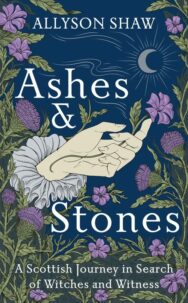‘During Lillias’s initial interrogation, she swore, “What I am to say shall be as true as the sun is in the firmament.”‘
In a powerful mix of memoir, travelogue and history, Allyson Shaw takes the reader around Scotland with the stories behind a handful of women who were convicted and executed as witches. In this extract from Ashes and Stones, we learn more about Lillias Adie, who faced trial in Torryburn in 1704.
Ashes and Stones: A Scottish Journey in Search of Witches and Witness
By Allyson Shaw
Published by Sceptre
Lillias’s accuser was a woman named Jean Bizet. Neighbours could come forward with accusations during a kirk session. In the session minutes, Jean Bizet describes going from house to house in the village one night, drinking. Near the end of the evening, she was seized with terror, convinced that Lillias was coming for her. Other witnesses heard Jean Bizet cry out, ‘O Lilly with her blew doublet! O Mary, Mary Wilson! Christ keep me,’ while wringing her hands and then passing out. According to the minutes, Jean Bizet was at a friend’s house late into the evening and was in a state of drunken distemper. She accused Lillias Adie of acting with Janet Whyte and Mary Wilson in a conspiracy. When Jean Bizet’s husband, James Tanochie, heard of this business, he said he would ‘ding the devil out’ of his wife.
Lillias was perhaps vulnerable as an elderly, single woman. The victims of the Scottish witch-hunts were overwhelmingly poor, older women. Lillias had an unusual appearance that perhaps marked her out from her neighbours. We know from the dimensions of Lillias’s coffin before it was destroyed that she was uncommonly tall. Her teeth were very prominent. Jean Bizet fixates on Lillias’s blue doublet, and from the scant statements at the trial, it’s impossible to know why this troubled Bizet. Was Lillias’s doublet brighter or finer than most? While this detail is seemingly inconsequential, it forms a fragment of Lillias as an individual woman, part of a time, a place and a people, and it helps us picture her. A blue doublet would have been a common garment at the time. The clothing of the poor was often dyed with woad, a yellow-flowered plant with tall stems and pale leaves. Woad blue is the blue of the sky reflected in the sea on a sunny day. That blue was the colour of much modest clothing, and had been for a millennia, and it was the blue Lillias wore.
Following the accusations of Jean Bizet, Lillias Adie was arrested by Bailie Williamson at 10 p.m. on 28 July 1704. Modern readers marvel at the confessions wrung from the accused during the witch-hunts, perhaps imagining women on a witness stand, confessing bizarre, sordid behaviour. This is often the way witch trials are portrayed in fiction. The reality is that, after arrest, the church needed evidence to take to the Privy Council in Edinburgh. The bulk of the evidence was the confession, extracted over months, during which the accused was often tortured, starved and sleep-deprived. There was no limit on how long the Kirk could hold someone before producing this ‘evidence’. The interrogators would ask leading questions: ‘When did you sleep with the devil?’ ‘Where did you meet other witches?’ and, crucially, ‘What are their names?’ These interrogations would have been intense. A room of powerful men questioning a terrified, tortured woman.
During Lillias’s initial interrogation, she swore, ‘What I am to say shall be as true as the sun is in the firmament.’ She confessed to a flurry of demonic meetings. Between interrogations, she was possibly held in the garret of the Townhouse of Culross – the seat of government and also a prison, where women accused as witches were confined and ‘watched’. The loft space where she was held had no fire for warmth, and what little light there was came up through the slats of the floor. A man would have been paid to watch her and keep her awake. Sleep deprivation was the most common form of torture used to extract confessions from the accused. It was effective. Lack of sleep for one or two nights created a docile suggestibility in the prisoner’s mindset. Longer periods of sleep deprivation resulted in hallucinations and deeper confusion.
Between Lillias’s trial record and everything that went unsaid and unrecorded, we must read her sufferings. The interrogators only wrote down what they thought they needed to convict her.
Perhaps she was led, in her exhaustion, to believe what was being asked of her. The crime of witchcraft involved merry-making with the devil, renunciation of Christian baptism, and the sex crime of ‘meeting with the devil carnally’. The ministers pointedly asked accused women if they’d had sex with Satan, and the churchmen wanted details.
Lillias was interrogated by the minister and church elders four times during the course of her month-long incarceration, which ended only because she died, perhaps of suicide or the effects of imprisonment on her aged body. The trial record states that Lillias had been meeting the devil since the previous witch-hunt in Torryburn in 1666. She would have seen these earlier public executions as a young woman. Over the course of their lives, almost everyone in early modern Scotland would have witnessed the spectacle of women strangled and burned at the stake. It was an event, and often ale was given to the spectators. The bonfire would have been seen for miles and the smoke would have lingered for days, a signal to other women. No one was safe; none were immune to accusation. This is how terror works.
Lillias’s interrogation went on; she met with a coven of ‘twenty or thirty’ witches, all now dead. She stated that she could not name the others, as they were ‘masked like gentlewomen’. As with all confessions extracted under torture, one must read beyond what is written. In this detail of others being dead or masked, we glimpse Lillias’s courage. Her interrogators wanted names, and she initially provided none. In her further confessions, she said that the devil had come to her hundreds of times and ‘lay with her carnally’. When he first trysted with her, it was at the hour just before sunset on Lammas, or the first of August, a transitional hour on the cross-quarter day in the harvest calendar. Lammas, or ‘Loaf Mass’, marked the midpoint between the summer solstice and the autumn equinox. At this pivotal moment, at an hour that was not quite night nor day, Lillias said she met the devil behind a stook, or bundled sheaf, set up in the field to dry. He was both pale and black, and his flesh was cold. Lillias added details: the devil wore a hat and arrived at their dances on a pony. Though he promised her much, she said he gave her only poverty and misery.
Ashes and Stones: A Scottish Journey in Search of Witches and Witness by Allyson Shaw is published by Sceptre, priced £18.99.
ALSO IN THIS ISSUE

 Rabbie’s Rhymes: Robert Burns for Wee Folk
Rabbie’s Rhymes: Robert Burns for Wee Folk
‘How can ye chant, ye little birds And I sae weary fu o’ care!’

 The Book . . . According to Victoria Mackenzie
The Book . . . According to Victoria Mackenzie
‘I wanted to show the very different ways that these two women coped with their visions, and also to …













